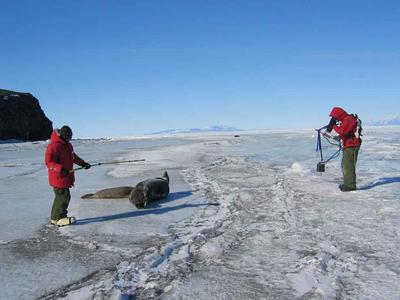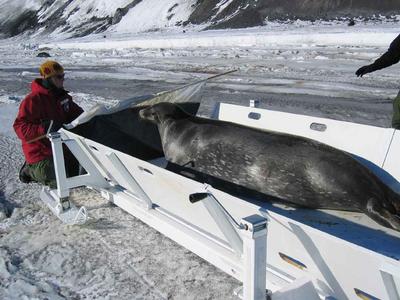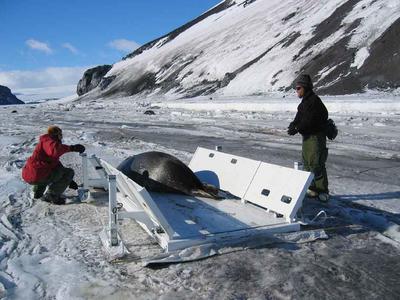13 November, 2003
Today we tried out the new 'road' that was bladed across the sastrugi
to the south side of Tent Island so that Darren could pull the weigh
sled over to the seal colony. This road is really just a slightly
smoother path that was created specifically for this purpose by a
heavy equipment operator on a large caterpillar tractor. Steve also
bladed a smoother road for us to Turk's Head, so the sled can be
towed to that colony too. So, instead of the Sastrugi Highway, we
can take the Tent Island Turnpike or the Turk's Head Freeway. While
we carried the camera equipment over in the pisten bully, Darren
pulled the sled behind his snowmobile. The road worked great, and
ended just where the relatively smooth ice began, allowing access to
some of the mothers and pups along Tent Island.
Today's total of 7 adults and 8 pups brings the total number of
animals weighed to 40 adults and 54 pups. Here's a few seal
statistics. Of the 40 adults, weights ranged from a low of 286 kg to
a high of 525 kg. Pup weights have ranged from a very low 17 kg to
yesterday's scale-topper of 60 kg. As the season progresses, some of
the pups are getting pretty darn big as they approach weaning weight.
Photographing the seals is almost as difficult as getting the adults
on the scale. Sometimes they lie compliantly on one side while you
hold the scale stick over or next to them, but most times they seem
to squirm from side to side, or roll onto their backs or bellies as
you wait patiently for the right moment to photograph. The optimum
seal position is on their side, with one flipper sort of in the
middle of their body and their rear flippers lying nicely, one on top
of the other. By trying to take all the photos with seals in
consistent positions, it decreases the variability that may be
encountered when trying to determine surface area; if all photos are
taken from the same perspective, then the surface area calculations
should also be reasonably similar. It is always important to
remember that these are animals that have never been told to lie
still for the photographer and show their best side to the camera-so
sometimes you take what you can get. By collecting a large sample of
photographs and weights, it's much easier to eliminate those that are
not quite perfect, and just use the ones that are taken from the
proper perspective.
Most of today's moms got on the scale. One took almost 20 minutes to
decide that it would be okay to climb on board next to her pup. One
mother was more like a freight train. She came barreling across the
scale's platform to her pup-and right out the other side. She was
undeterred when we raised the curtain at the far end of the scale
that's designed to stop the seal from waddling right out the end. In
fact, she repeated her performance three times until we decided that
maybe she wasn't the best candidate for having an accurate weight
taken. It's difficult to get a good reading on a moving animal!
Daily Haiku:
The weighing of seals
Requires patience and some luck
Won't you hop on board?

Darren and Brent work to get a side-view photo of this seal.

Here's Darren with his backpack-mounted camera system setup for side-views of the seals.

Darren puts up the curtain at the end of the sled to keep the seal from exiting too soon. All field researchers receive a variety of support from afar--his mother made the curtains for the sled, as well as the quilted hoods that fit over the camera viewers.

This compliant mother waits while we get her weight. As a point of reference, the scale bed is 10 feet long, so you can see how big she is.

This mother was quick to exit after we got her weight.
Contact the TEA in the field at
.
If you cannot connect through your browser, copy the
TEA's e-mail address in the "To:" line of
your favorite e-mail package.
|
